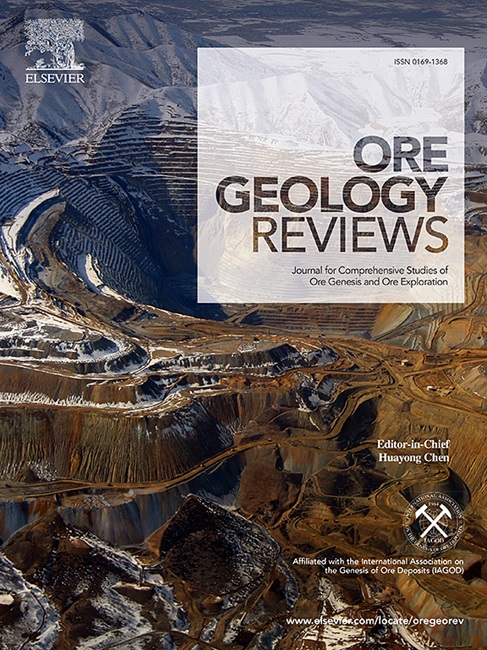刚果(金)北基伍省Bisie木锡(锡石)矿床地质及其寄主岩
IF 3.2
2区 地球科学
Q1 GEOLOGY
引用次数: 0
摘要
Bisie锡矿位于刚果民主共和国的中元古代基伍带,是世界上品位最高的锡矿,平均锡品位为4.5%。在这项研究中,我们提供了矿床及其周围矿山许可区域的地质描述,并提供了相邻花岗岩地块的U-Pb年代学数据。比西锡矿变质沉积寄主岩主要有:(1)云母片岩和嵌段基性、长英质侵入挤压岩;(2)碎屑的“变质沉积单元”,包含基性凝灰岩成分;(3)碳质页岩。变质等级在离花岗岩地块越远的地方越低,在层序上越高。云母片岩表现为一峰变质组合,主要由星绿石、石榴石和黑云母组成。过度生长的以白蝇为主的叶理。花岗岩地块发生了多期岩浆作用,其中体积最大的是无日期黑云母正长花岗岩。亚侵入岩还包括碱性花岗岩、正长岩和二长花岗岩。边缘二长花岗岩产生1271 ~ 1273 Ma的U-Pb锆石年龄,表明长英质岩浆活动与周围变质沉积发育部分同步。前人的研究表明,该花岗岩的年龄为1518±40 Ma,早于基巴兰造山运动的开始,花岗岩地块内的麻质岩的最大年龄约为1000 Ma,与G4花岗岩阶段同期。花岗岩地块可能形成于前基巴兰岩石的伸展环境(变质核杂岩)中,随后被基巴兰花岗岩相侵入。比奇矿床位于工程北部离花岗岩接触面约500 m的云母片岩中。锡矿化赋存于与花岗岩地块接触平行的陡东倾剪切带中。沿剪切带发育14 km蚀变晕,表现为白云母(±绿泥石)取代变质斑母岩,土壤覆盖层发育锡异常。锡矿化发生在高达1米宽的矿脉中(所谓的木锡)。脉体位于绿泥石(±放线石)片岩的蚀变包层内,宽约25米。高品位矿脉以中角向北倾出,含褶皱矿脉,低品位矿脉无褶皱矿脉,与剪切带平行呈N(NW)向矿脉。剪切带的持续变形导致锡石脉强烈的边界化和角化。锡石以前的年代为~ 1068-1026 Ma,与G4花岗岩阶段同时形成。石英脉纹和黄铁矿、黄铜矿、毒砂(±闪锌矿和方铅矿)的沉淀与后期的NW向、NNW向和e - w向断裂有关,这些断裂对锡矿化剪切带进行了解剖。北西向断裂将比西矿床划分为南、北两个矿体。正常运动和走滑运动的多个阶段重新激活了这些断层。在姆帕马南部地区,块状硫化物透镜体与推断的同沉积起源接近于锡矿化。本文章由计算机程序翻译,如有差异,请以英文原文为准。

Geology of the Bisie wood tin (cassiterite) deposit and its host rocks, North Kivu Province, DR Congo
The Bisie Tin Mine, located in the Mesoproterozoic Kivu Belt in the Democratic Republic of Congo, is the world’s highest-grade tin operation with an average grade of 4.5 % Sn. In this study we provide a geological description of the deposit and its surrounding mine license area and present U-Pb geochronological data for an adjacent granite massif.
The metasedimentary host rocks of the Bisie Tin Mine comprise: (1) Mica schists and intercalated mafic and felsic intrusive and extrusive rocks; (2) a “metasedimentary unit” of clastics, containing a mafic tuff component and (3) carbonaceous shale. The metamorphic grade decreases away from the granite massif and upwards in the stratigraphic sequence. The mica schist displays a peak metamorphic assemblage of staurolite, garnet and biotite. overgrowing a muscovite-dominated foliation.
Multiple stages of magmatism occurred in the granite massif, including an undated biotite syenogranite as the most voluminous phase. Further sub-intrusions include alkaline granites, syenites and monzogranites. A marginal monzogranite yields 1271–1273 Ma U-Pb zircon ages, indicating that felsic magmatism was partially synchronous with the development of surrounding metasediments. A previous study reported a granite age of 1518 ± 40 Ma, pre-dating the onset of the Kibaran orogeny and gneissic rocks within the granite massif with a maximum age of around 1000 Ma, contemporaneous with the G4 granite stage. The granite massif likely formed in an extensional environment (metamorphic core complex) exhuming pre-Kibaran rocks, and was subsequently intruded by Kibaran granite phases.
The Bisie deposit is located in mica schist about 500 m from the granite contact in the northern project area. Tin mineralisation is hosted in a steeply east-dipping shear zone oriented parallel to the contact with the granite massif. Along the shear zone, an alteration halo is developed for >14 km – manifested in the replacement of metamorphic porphyroblasts by muscovite (± chlorite) and development of Sn anomalies in the soil cover.
Tin mineralisation occurs as up to ∼1 m wide veins of botryoidal cassiterite (so-called wood tin). The veins are hosted within an up to ∼25 m wide alteration envelope of chlorite (± actinolite) schist. High-grade ore shoots plunge at intermediate angle to the north and contain folded veins, absent in low grade zones, as well as N(NW)-trending veins paralleling the shear zone. Continued deformation in the shear zone caused cassiterite veins to be strongly boudinaged and brecciated. Cassiterite previously dated to ∼1068–1026 Ma, formed contemporaneously with the G4 granite stage. Quartz veining and precipitation of pyrite, chalcopyrite, arsenopyrite (± sphalerite and galena) are associated with later NW-, NNW- and E-W-trending faults that dissect the tin-mineralised shear zone. NW-trending faults segmented the Bisie deposit into the Mpama North and South ore bodies. Multiple phases of normal and strike-slip movement reactivated these faults..
Massive sulphide lenses with an inferred syn-sedimentary origin occur proximal to the tin mineralisation in the Mpama South area.
求助全文
通过发布文献求助,成功后即可免费获取论文全文。
去求助
来源期刊

Ore Geology Reviews
地学-地质学
CiteScore
6.50
自引率
27.30%
发文量
546
审稿时长
22.9 weeks
期刊介绍:
Ore Geology Reviews aims to familiarize all earth scientists with recent advances in a number of interconnected disciplines related to the study of, and search for, ore deposits. The reviews range from brief to longer contributions, but the journal preferentially publishes manuscripts that fill the niche between the commonly shorter journal articles and the comprehensive book coverages, and thus has a special appeal to many authors and readers.
 求助内容:
求助内容: 应助结果提醒方式:
应助结果提醒方式:


